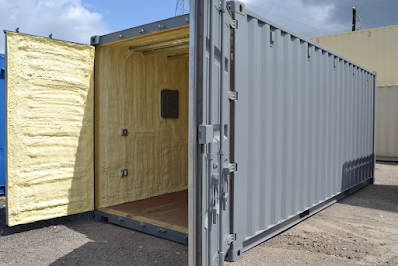Shipping containers are a popular and cost-effective way to
store and transport goods, but they can also be prone to condensation. This is
due to the high humidity levels inside the container and the temperature
differences between the inside and outside. Condensation can cause damage to
the goods stored inside, as well as the container itself. In this guide, we
will go over some tips on how to stop condensation in a damp shipping
container.
Understanding Condensation
When warm air hits a cold surface, this is called
condensation. For example, inside a shipping container, warm air is created by
the goods stored inside and the people working inside. The cold surface is the
metal walls and roof of the container. When the warm air comes into contact
with the cold surface, it cools down and turns into water droplets, which can
then settle on the goods and container.
Preventing Condensation
Insulation
Insulating a shipping container is one of the most effective
ways to prevent condensation. Insulation helps to keep the temperature inside
the container more consistent, reducing the temperature difference between the
inside and outside. This can be done using insulation panels, paint, or
blankets.
Ventilation
Proper ventilation is also important for preventing
condensation in a shipping container. By installing vents or air vents, you can
allow fresh air to circulate inside the container, which will help to reduce
the humidity levels. It is also important to keep the container doors open as
much as possible to allow fresh air to circulate inside.
Dehumidifiers
Another way to prevent condensation in a shipping container
is by using a dehumidifier. These devices help remove excess moisture from the
air, reducing the humidity levels inside the container. Dehumidifiers can be
portable or installed permanently, depending on your needs.
Heating
In case of cold weather, heating can be used to keep the
container warm and prevent condensation. This can be done using portable
heaters or installing a permanent heating system.
Tips for Managing Condensation
Observe the temperature and relative humidity levels.
It is important to keep an eye on the temperature and
humidity levels inside the container. This can be done by using a thermometer
and hygrometer, which will give you an accurate reading of the conditions
inside the container.
Wipe down the container regularly.
To prevent water droplets from settling on the goods and
container, it is important to wipe down the container regularly. This can be
done with a damp cloth or a squeegee.
Place container desiccant or moisture-absorbing materials
Placing container desiccant
or moisture-absorbing materials such as silica gel packets or calcium chloride
can help to absorb the excess moisture and prevent condensation.
Use a rust inhibitor.
Condensation can also cause rust on the container, so it is
important to use a rust inhibitor to protect the container from rusting.
Conclusion
Condensation can be a major problem in shipping containers,
but it can be prevented and managed with the right techniques. Insulation,
ventilation, dehumidifiers, and heating are all effective ways to prevent
condensation. In addition, keeping an eye on the temperature and humidity
levels, wiping down the container regularly, placing moisture-absorbing
materials, and using a rust inhibitor can also help to manage condensation. By
following these tips, you can ensure that your goods are protected and that
your container stays in good condition.

Comments
Post a Comment